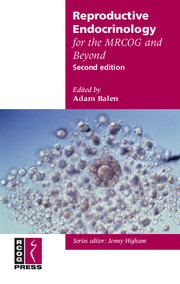Book contents
- Frontmatter
- Contents
- Acknowledgements
- Preface to the first edition
- Preface to the second edition
- Abbreviations used in this book
- 1 Sexual differentiation: intersex disorders
- 2 Adrenal disorders
- 3 Normal puberty and adolescence
- 4 Abnormal puberty
- 5 The menstrual cycle
- 6 Disorders of menstruation
- 7 Amenorrhoea
- 8 Polycystic ovary syndrome
- 9 Health consequences of polycystic ovary syndrome
- 10 Anovulatory infertility and ovulation induction
- 11 Lactation and lactational amenorrhoea
- 12 Hyperprolactinaemia
- 13 Thyroid disease
- 14 Diabetes
- 15 Lipid metabolism and lipoprotein transport
- 16 Premature ovarian failure
- 17 Calcium metabolism and its disorders
- Appendix: Endocrine normal ranges
- Further reading
- Index
8 - Polycystic ovary syndrome
Published online by Cambridge University Press: 05 August 2014
- Frontmatter
- Contents
- Acknowledgements
- Preface to the first edition
- Preface to the second edition
- Abbreviations used in this book
- 1 Sexual differentiation: intersex disorders
- 2 Adrenal disorders
- 3 Normal puberty and adolescence
- 4 Abnormal puberty
- 5 The menstrual cycle
- 6 Disorders of menstruation
- 7 Amenorrhoea
- 8 Polycystic ovary syndrome
- 9 Health consequences of polycystic ovary syndrome
- 10 Anovulatory infertility and ovulation induction
- 11 Lactation and lactational amenorrhoea
- 12 Hyperprolactinaemia
- 13 Thyroid disease
- 14 Diabetes
- 15 Lipid metabolism and lipoprotein transport
- 16 Premature ovarian failure
- 17 Calcium metabolism and its disorders
- Appendix: Endocrine normal ranges
- Further reading
- Index
Summary
Polycystic ovary syndrome (PCOS) is the most common endocrine disturbance that affects women; yet it is only in recent times that we have begun to piece together a clearer idea of its pathogenesis. PCOS is a heterogeneous collection of signs and symptoms that, gathered together, form a spectrum of a disorder with a mild presentation in some, while in others it presents as a severe disturbance of reproductive, endocrine and metabolic function. The pathophysiology of PCOS appears to be multifactorial and polygenic. The definition of the syndrome has been much debated. Key features include menstrual cycle disturbance, hyperandrogenism and obesity. There are many extra-ovarian aspects to the pathophysiology of PCOS but ovarian dysfunction is central. At a joint consensus meeting of the European Society of Human Reproduction and Embryology (ESHRE) and the American Society for Reproductive Medicine (ASRM), a refined definition of the PCOS was agreed: the presence of two out of the following three criteria:
• oligo- and/or anovulation
• hyperandrogenism (clinical and/or biochemical)
• polycystic ovaries, with the exclusion of other aetiologies.
The morphology of the polycystic ovary has been redefined as an ovary with 12 or more follicles measuring 2-9 mm in diameter and/or increased ovarian volume (greater than 10 cm3).
There is considerable heterogeneity of symptoms and signs in women with PCOS (Box 8.1) and for an individual these may change over time. Polycystic ovaries can exist without clinical signs of the syndrome, expression of which may be precipitated by various factors, predominantly an increase in body weight.
- Type
- Chapter
- Information
- Reproductive Endocrinology for the MRCOG and Beyond , pp. 89 - 102Publisher: Cambridge University PressPrint publication year: 2007



